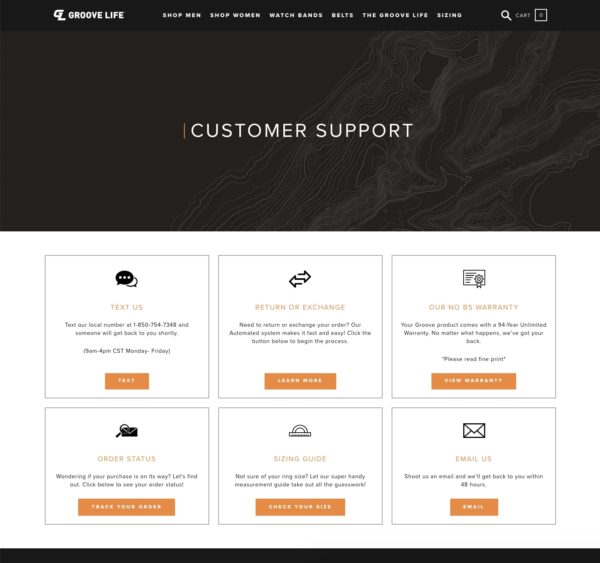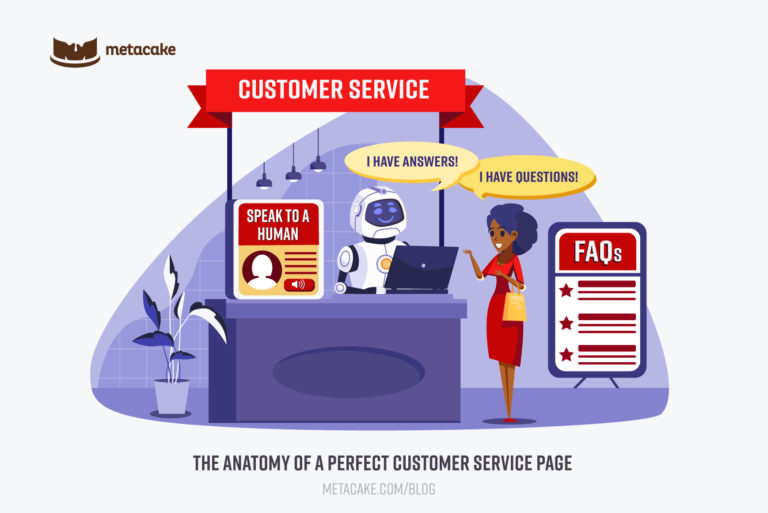We’ve said it before, and it bears repeating: customer service is the frontline of fan creation for ecommerce brands. It is a prime opportunity to turn site visitors or customers into devoted brand fans, instantly increasing their lifetime value.
The strategy for this switch is simple. When customers come to customer service, more often than not, it’s because they have a problem. Their interaction with customer service presents the opportunity for your team to turn frustration or stress into extreme gratitude, depending on how it’s handled.
Many brands think great customer service will cost them money, but that doesn’t have to be the case. Ideally, those expenses would be built into your business model so that you can assist customers without losing money (this is why great product margins are so important).
What is the Benefit of Having a Great Customer Service Page?
A great customer service page makes it quick for customers to self-solve common problems, while also making it easy to elevate an issue to a person. The goal is to use information and technology intelligently, so that humans are spending time on the issues that actually require a human touch.
If you’re going to supply fantastic customer service, you need a central hub to get the process started. That’s where a thoughtful customer service page comes into play. Designing a great page will help filter customers to the best place to solve their issue quickly and with little to no frustration. Only getting humans involved when truly necessary will help keep the process efficient. In short, a great customer service page keeps both the customer and your team members happy. A bad page will frustrate customers and waste your staff’s time on the wrong issues.
What Strategy Should Be Used on the Customer Service Page?
The most effective strategy for a customer service page combines two approaches: the ability to self-solve and the opportunity to easily connect with a human representative.
We typically see brands go one of two directions on a customer service page: They either make it impossible to talk to someone and leave the customer to self-solve everything. Or, the only content on the page is a “Contact Us” box with their phone number and email address. This may be the “easy” way to build a page, but it’s going to cause issues in efficiency and customer satisfaction in the long run.
On the customer experience side, customers should find that it’s easy to solve 80% of their problems relatively quickly, as well as easy to elevate issues to a real human when necessary. Most people don’t actually want to pick up the phone and call someone if the question or problem can be easily solved on their own.
For areas that do require a human’s help, make sure you set expectations about availability. Add a message about what time zone your team is in, typical response time, etc. This is key in minimizing customer frustration.
In this post, we will outline the four essential elements of a customer service page that will help solve customers’ problems and make your team more efficient, ultimately creating more brand fans.
Four Essential Elements of a Customer Service Page
For the majority of the page, you can think about the page’s structure in terms of levels, elements that address different degrees of customer questions/concerns.
Level 0: Urgent Messaging (As Needed)
Before anything else, it’s important to have the availability at the top of the page for urgent messages. For example, in cases of inclement weather or busy holiday rushes, shipping may be delayed. It’s important to flag that to help manage customers’ expectations during those times.
Level 1: Preempt Common Sales-Related Questions
Level 1 elements address common questions that customers have before purchasing your products. This could include a number of things and will probably be unique to your product. Here are a few options to consider addressing:
- Product specific questions. For example, sizing guides, how to use the product, product ingredients, etc.
- Common areas of misunderstanding. This could be anything that people reach out to customer service to ask about before purchasing.
- Common objections. It’s extremely helpful to address these here to disarm, inform, and build trust. This helps sell your products as well.
- Warranty Info. If your product comes with a warranty or guarantee, the customer service page is likely the first page for people to look for it.
- FAQs. This can be a great way to help visitors self-solve. Encourage your customer service team to keep a running list of questions they get asked most often and use this as a foundation for your FAQs section.
Level 2: Handle Common Customer Issues
Level 2 elements handle common questions or issues from those who have purchased. Use this section to provide quick, automated solutions to these common issues. For example:
- Order Status: Provide a simple, automated system for helping a customer track down their order.
- Account login issues: Include directions for how to log in to their account and/or how to reset their password.
- Start the return or exchange process: Typically this can take up a lot of the customer service team’s time. Alleviate that by automating the beginning of the return or exchange process for better efficiency.
Level 3: Elevate to a Customer Service Person
There are certain issues that only a human should solve, and that is what this element is for. Make it as simple as possible for a customer to get in touch with your team to resolve their problem quickly by providing more than just a support email. Consider including:
- Customer support email
- Help chat, either using a chat tool on your site, Facebook Messenger, or SMS
- Phone number
- Video support
Note: Be sure to set expectations for response time to help avoid any customer frustration. Mention what time of day your support team is available to help and what time zone you operate in.
Utilize Technology for Efficiency and Scale
The final element that is essential for any business is a customer support tool that allows your customer service team to effectively solve problems in a scalable way. One of the best tools out there is Zendesk, or if you’re on Shopify, Gorgias is also extremely helpful. These tools leverage AI and bots to help solve many common questions over chat, freeing up your customer service team to handle requests that actually require a human.
If you do use a chat tool, choose one that is intelligent, capable of handling common questions and scaling that service. It needs to integrate well with your customer support system and have the option to program common questions into the chat for automated, helpful responses.
Lastly, a CRM is essential for multiple reasons in ecommerce— customer service included. An effective CRM will capture business data so you can use it to better serve your customers. Your customer support tool of choice should integrate with your CRM so that data flows to the CRM.
Example of an Effective Customer Service Page
Now that you know the elements necessary to include on a customer service page, you may be wondering what it looks like when you put it all together. One of the best examples of a customer service page that actually serves customers well comes from Groove Life, an outdoor brand that specializes in active silicone wedding rings. We helped them create a simple yet highly effective page that quickly routes customers where they need to go, with options for self-service and elevating to a human representative. Check it out below!

It’s Time to Upgrade Your Customer Service Experience
With customer service being the front line of brand fan creation, you can’t afford not to have a great customer service experience. And that starts with a well-designed customer service page. Build this the right way and you’ll set your customers up for success, turning frustrations into gratitude and ultimately creating loyal customers that will become fans for life.
